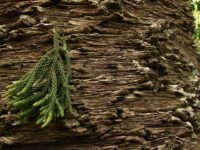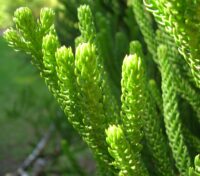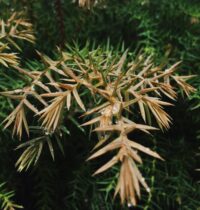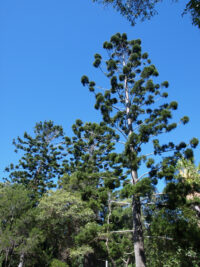Araucaria cunninghamii, commonly known as the Hoop Pine, is a coniferous tree native to Australia.
This evergreen tree is renowned for its straight trunk, attractive foliage, and high-quality timber.
Taxonomy:
- Family: Araucariaceae
- Genus: Araucaria
Description:
- Growth: Large tree that can grow up to 60 meters in height, with a trunk diameter of up to 1.5 meters. The bark is rough and gray, with horizontal ridges that resemble hoops, giving the tree its common name.
- Leaves: Dark green, needle-like, and arranged spirally around the branches. Juvenile leaves are softer and broader, while adult leaves are more rigid and scale-like.
- Male Cones: Smaller than female cones, typically measuring 5 to 10 cm in length. They are cylindrical and often appear in clusters.
- Female Cones: 10 to 15 cm in length and 7 to 10 cm in diameter. They are roughly spherical or ovoid.
- Seed: Elongated, measuring about 2 to 3 cm in length. Each seed has a broad, flat wing that aids in wind dispersal.
Habitat and Distribution:
Araucaria cunninghamii is native to the coastal and sub-coastal rainforests of eastern Australia, from northern New South Wales to northern Queensland, and parts of New Guinea. It thrives in warm, humid environments and prefers well-drained, fertile soils.
Hosts:
- Sulphur-crested Cockatoo (Cacatua galerita): Feeds on seeds and occasionally buds and young shoots. These cockatoos often break open cones to access seeds, aiding in seed dispersal.
- Australian King Parrot (Alisterus scapularis): Consumes seeds directly from the cones. Helsp in the natural pruning of the tree as they feed on seeds and young shoots.
- Topknot Pigeon (Lopholaimus antarcticus): Feeds on the seeds, contributing to seed dispersal and forest regeneration.
- Australian Brush-tailed Possum (Trichosurus vulpecula): Browses on leaves and young shoots. While feeding can sometimes damage young trees, the possum plays a role in shaping the vegetation structure of Hoop Pine forests.
- Bush Rat (Rattus fuscipes): Consumes seeds and may cache them, aiding in seed dispersal. The caching behavior can lead to the germination of seeds in new locations.
- Hoop Pine Moth (Agathodes ostentalis): Larvae feed on the leaves and young shoots. Although heavy infestations can be detrimental, moderate feeding is part of the natural ecological balance.
- Pine Loopers (family Geometridae): Caterpillars feed on the foliage of Hoop Pine. While outbreaks can cause defoliation, the tree generally recovers well.
Ecology and Uses:
- Timber: Straight grain, uniform texture, and ease of working make Hoop Pine timber ideal for crafting high-quality furniture. Durability and attractive appearance of also make it a popular choice for flooring
- Ornamental: Its symmetrical shape and evergreen foliage make it an attractive landscape feature.
- Windbreaks and Shelterbelts: Planted in rows to act as windbreaks or shelterbelts, protecting crops and livestock from harsh winds.
- Plantation Forestry: Grown in plantations in Australia and other countries for commercial timber production.
Links:
Araucaria cunninghamii : Hoop Pine | Atlas of Living Australia (ala.org.au)
- Bark up close
- Leaves up close
- New growth up close
- Juan Carlos López Almansa, CC BY-SA 2.0, via Wikimedia Commons





